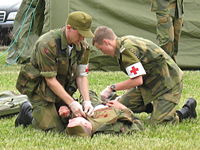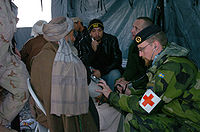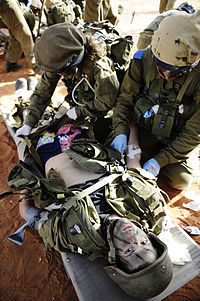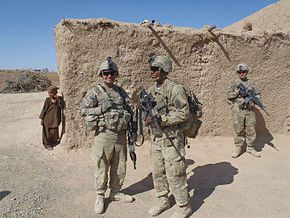- Combat medic
-
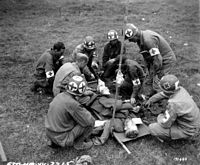 Medical team at work during the Battle of Normandy.
Medical team at work during the Battle of Normandy. Norwegian medics during an exercise.
Norwegian medics during an exercise.
Combat medics (also known simply as medics) are trained military personnel who are responsible for providing first aid and frontline trauma care on the battlefield. They are also responsible for providing continuing medical care in the absence of a readily available physician, including care for disease and battle injury. Combat medics are normally co-located with the combat troops they serve in order to easily move with the troops and monitor ongoing health. In 1864, sixteen European states (referring to themselves as "High Contracting Parties"), adopted the First Geneva Convention to save lives, to alleviate the suffering of wounded and sick military personnel, and to protect trained medical personnel as civilians, in the act of rendering aid.
Chapter IV, Article 25 of the Geneva Convention states that "Members of the armed forces specially trained for employment, should the need arise, as hospital orderlies, nurses or auxiliary stretcher-bearers, in the search for or the collection, transport or treatment of the wounded and sick shall likewise be respected and protected if they are carrying out these duties at the time when they come into contact with the enemy or fall into his hands." Article 29 reads "Members of the personnel designated in Article 25 who have fallen into the hands of the enemy, shall be prisoners of war, but shall be employed on their medical duties insofar as the need arises."
According to the Geneva Convention, knowingly firing at a medic wearing clear insignia is a war crime.[1]
In modern times, most combat medics carry a personal weapon, to be used to protect themselves and the wounded or sick in their care.[2] When and if they use their arms offensively, or carry arms that qualify as offensive, they then sacrifice their protection under the Geneva Conventions.[3]
Contents
History
Surgeon Dominique Jean Larrey directed the Grande Armée of Napoleon to develop mobile field hospitals, or "ambulances volantes" (flying ambulances), in addition to a corps of trained and equipped soldiers to aid those on the battlefield. Before Larrey's initiative in the 1790s, wounded soldiers were either left amid the fighting until the combat ended or their comrades would carry them to the rear line.
It was during the American Civil War that Surgeon (Major) Jonathan Letterman, Medical Director of the Army of the Potomac, realized a need for an integrated medical treatment and evacuation system. He saw the need to equip this system with its own dedicated vehicles, organizations, facilities, and personnel. The Letterman plan was first implemented in September 1862 at the Battle of Antietam, Maryland. The United States Army’s need for medical and scientific specialty officers to support combat operations resulted in the creation of two temporary components: the US Army Ambulance Service, established on June 23, 1917 and the Sanitary Corps, established on June 30, 1917. Officers of the Sanitary Corps served in medical logistics, hospital administration, patient administration, resource management, x-ray, laboratory engineering, physical reconstruction, gas defense, and venereal disease control. They were dedicated members of the medical team that enabled American generals to concentrate on enemy threats rather than epidemic threats. On August 4, 1947, Congress created the Medical Service Corps.[4]
In the United States, a report entitled "Accidental Death and Disability: The Neglected Disease of Modern Society (1966)", was published by National Academy of Sciences and the National Research Council. Better known as "The White Paper" to emergency providers, it revealed that soldiers who were seriously wounded on the battlefields of Vietnam had a better survival rate than those individuals who were seriously injured in motor vehicle accidents on California freeways. Early research attributed these differences in outcome to a number of factors, including comprehensive trauma care, rapid transport to designated trauma facilities, and a new type of medical corpsman, one who was trained to perform certain critical advanced medical procedures such as fluid replacement and airway management, which allowed the victim to survive the journey to definitive care.
Red Cross, Red Crescent, and MDA
The International Committee of the Red Cross, a private humanitarian institution based in Switzerland, provided the first official symbol for medical personnel. The first Geneva convention, originally called for "Amelioration of the Condition of the Wounded and Sick in Armed Forces in the Field," officially adopted the red cross on a field of white as the identifying emblem. This symbol was meant to signify to enemy soldiers that the medic qualifies as a noncombatant, at least while providing medical care.[5] Islamic countries use a Red Crescent instead. During the 1876-1878 war between Russia and Turkey, the Ottoman empire declared that it would use a red crescent instead of a red cross as its emblem, although it agreed to respect the red cross used by the other side. Although these symbols were officially sponsored by the International Federation of Red Cross and Red Crescent Societies, the Magen David Adom ("MDA"), Israel's emergency relief service, used the Magen David (a red star of David on a white background). Israeli medics still wear the Magen David. To enable MDA to become a fully recognized and participating member of the International Red Cross and Red Crescent Movement, Protocol III was adopted. It is an amendment to the Geneva Conventions relating to the Adoption of an Additional Distinctive Emblem and authorizes the use of a new emblem, known as the third protocol emblem or the Red Crystal. For indicative use on foreign territory, any national society can incorporate its unique symbol into the Red Crystal. Under Protocol III, the MDA will continue to employ the red Magen David for domestic use, and will employ the red crystal on international relief missions.
Modern day
 US Navy Hospital Corpsman providing treatment to a wounded Iraqi soldier, 2003.
US Navy Hospital Corpsman providing treatment to a wounded Iraqi soldier, 2003.
Traditionally, medical personnel did not carry weapons and wore a distinguishing red cross, to denote their protection as noncombatants under the Geneva Convention. This practice continued into World War II. However, the enemies faced by professional armies in more recent conflicts are often insurgents who either do not recognize the Geneva Convention, or do not care, and readily engage all personnel, irrespective of noncombatant status. For this reason, some modern combat medics are armed combatants and do not wear distinguishing markings.[citation needed] Combat Medics in the United States Army and United States Navy Hospital Corpsman are virtually indistinguishable from regular combat troops, except for the extra medical equipment they carry.
The colloquial form of address for a Hospital Corpsman or Medic is "Doc." In the U.S. Marine Corps, this term is generally used as a sign of respect. The US Navy deploys Corpsman attached to US Marine Corps units as part of the Fleet Marine Force (FMF). The US Marines does not maintain a medical corps and relies on Navy corpsmen and other Naval medical personnel for medical care.
USAF medics have frequently served attached to US Army units in recent conflicts. Though all combat medical personnel are universally referred to as "medic", within different branches of the US military, the skill level, quality of training and scope of work performed by medics varies from branch to branch.
See also
- 68W (medic; U.S. Army)
- Ambulance -- Military use
- Battlefield medicine
- Brain Trauma Foundation
- Combat support hospital
- Enlisted Medics (U.S. Air Force)
- Flight medic
References
- STP 8-91W15-SM-TG SOLDIER'S MANUAL AND TRAINER'S GUIDE, MOS 91W, HEALTH CARE SPECIALIST, SKILL LEVELS 1/2/3/4/5
- ^ "International Humanitarian Law - First 1949 Geneva Convention". Icrc.org. 1949-08-12. http://www.icrc.org/ihl.nsf/WebART/365-570030?OpenDocument. Retrieved 2010-12-13.
- ^ "International Humanitarian Law - First 1949 Geneva Convention". Icrc.org. 1949-08-12. http://www.icrc.org/ihl.nsf/WebART/365-570027?OpenDocument. Retrieved 2010-12-13.
- ^ "International Humanitarian Law - First 1949 Geneva Convention". Icrc.org. 1949-08-12. http://www.icrc.org/ihl.nsf/WebART/365-570026?OpenDocument. Retrieved 2010-12-13.
- ^ [1]
- ^ "International Humanitarian Law - First 1949 Geneva Convention". Icrc.org. 1949-08-12. http://www.icrc.org/ihl.nsf/WebART/365-570047?OpenDocument. Retrieved 2010-12-13.
External links
- Corpsman.com – a website run by Docs for Docs of all US military services
- 90th Infantry Division / 315th Medical Batallion webpage (90th Infantry Division Preservation Group website) – has links to other pages showing equipment of US, German and Japanese medics
- http://home.att.net/~steinert/ WWII medics
- National Registry of Emergency Medical Technicians
- National Association of Emergency Medical Technicians
- NHTSA Emergency Medical Services official website (U.S. National Highway Traffic Safety Administration)
Categories:- Military medicine
- Emergency medicine
- Combat occupations
Wikimedia Foundation. 2010.

